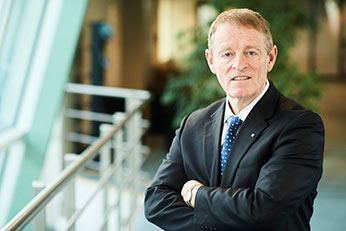 On 1 January, Eamonn Brennan was appointed as Director General of EUROCONTROL. In this article, he explains where he is focusing his energy right now and in the coming months, and how partnerships and collaboration, like those exemplified in SESAR, can help address challenges facing air traffic management in Europe.
On 1 January, Eamonn Brennan was appointed as Director General of EUROCONTROL. In this article, he explains where he is focusing his energy right now and in the coming months, and how partnerships and collaboration, like those exemplified in SESAR, can help address challenges facing air traffic management in Europe.
In your new role as Director General of Eurocontrol, where are you placing your energy and focus right now?
When I arrived in the Agency, I was able to see first-hand the value that EUROCONTROL can bring to all the different areas of ATM with both its operational excellence and tremendous technical expertise. However I can also see that EUROCONTROL will only be able to deliver a maximum contribution to European ATM when a true and efficient partnership is in place with all our ATM stakeholders and when EUROCONTROL’s role is fully embedded in their strategy. From that perspective, the SESAR JU framework is clearly a role model, with EUROCONTROL’s contribution being negotiated and agreed with all key players (be it ANSPs, Airports or manufacturing Industries, national Military). I would like to see that level of cooperation in place with all our stakeholders.
What do you see is the added value of Eurocontrol in today’s ATM/aviation landscape? How does Eurocontrol’s contribution as role as founding member to the SESAR Joint Undertaking help create further added value?
EUROCONTROL brings its pan-European view, its global knowledge of the European network and of all the interactions between the individual elements that compose this network. It also brings its neutrality and the unique ATM expertise that is built on more than 50 years of work at European level. We provide an efficient cooperation framework to the European Commission and our 41 member states, concentrating critical resources while sharing the costs. We support them with a top level ATM organisation able to discuss with the FAA and ICAO on equal footing. We also offer a unique bridge to tackle the European civil –military ATM coordination. This gives SESAR a sharper and more powerful expertise and enables it to disseminate results, obtain feedback and maximise benefits on a wider geographical scope and with a stronger voice.
What would you say are the main challenges and opportunities facing European aviation/air traffic management? How can partnerships and collaboration, like those exemplified in SESAR, help address these challenges?
Traffic growth has taken off again in Europe - last summer’s traffic was almost 5% above summer 2016, so capacity is once again becoming a strong driver for R&D. However productivity and lower costs are also critical and we still need to promote new ATM architecture and new business models to meet our objectives and reach similar levels of productivity as those seen in the United States. Most of the promising solutions delivered by SESAR are still to be implemented in the real operational world. I believe a special effort needs to be done to accelerate the deployment of SESAR, with a particular focus on projects that promote defragmentation and interoperability including its civil-military dimension.
New challenges are also arising with the proliferation in the use of drones, promoted by particularly inventive and dynamic stakeholders, but ones who often have a limited experience of the ATM domain and its very demanding safety culture. Security and more particularly cyber security are also topical issues that require new ways of exchanging data and developing architecture.
These challenges require that all stakeholders and all experts come together to pool their intelligence, cooperate, develop and then implement solutions at a speed which is unfamiliar in the aviation world. A framework like the SESAR JU has proven that it can bring together all the different parties around shared objectives. Discussions have already started on the future “post 2020 European ATM institutional framework”. I want us to learn from the positive experience of the SESAR JU and build on it. We are very open, as I know EUROCONTROL will be agile enough to adapt itself to whatever the final setup may be.
